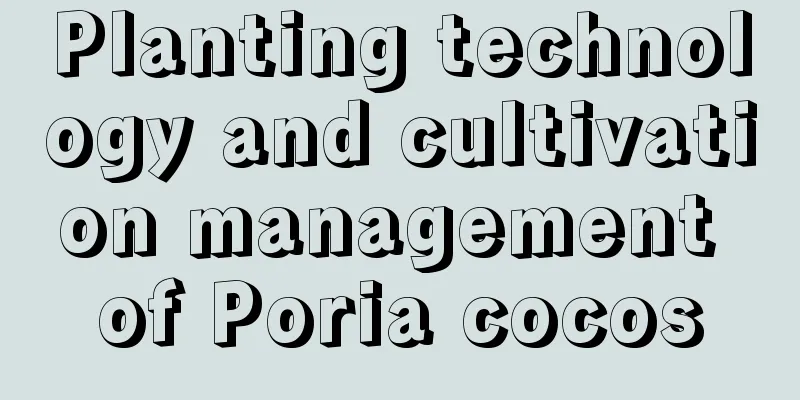Planting technology and cultivation management of Poria cocos

|
Poria cocos is a traditional Chinese medicinal material widely used in clinical practice. Its traditional cultivation mainly involves selecting tree stumps, peeling bark, digging soil, sowing, covering soil, field management, harvesting and processing. The appearance of Poria cocos may be spherical, oval, oblate or irregular lumps of varying sizes. Its skin is thin and rough in texture, ranging in color from tan to dark brown, with obvious wrinkles and textures on the surface. Let’s learn about the planting techniques and cultivation management of Poria cocos. 1. Preparation of bacterial strains 1. Mother stock culture (1) Culture medium preparation The recipe is 250g potatoes (chopped), 50g sucrose, 20g agar, 3g urea, add water to 1000mL. The operation steps are: first weigh and chop 250g of potatoes, add 1000mL of water and boil for half an hour, filter the juice with gauze, add agar to the filtrate and boil until completely dissolved, then add sucrose and urea, and add water to 1000mL after complete dissolution, adjust the pH to 6~7, divide it into test tubes, sterilize it under high pressure for 30 minutes, cool and solidify, and prepare for inoculation. (2) Preparation of stock and cultivars Raw material ratio: 70% pine sawdust, 20% corn crumbs, 8% wheat bran or rice bran, 1% white sugar, 1% gypsum powder, add into a bucket and mix evenly. Add a disinfectant containing carbendazim, mix the raw materials and liquid evenly, and adjust the moisture to 60%-65% (judgment method: squeeze it into a ball, and your palm feels moist). Sterilization: High pressure or normal pressure sterilization can be used. Normal pressure sterilization is more economical. Sterilize until the canvas bulges and then count for 26 hours. Inoculate after cooling. 2. Cultivation Technology (1) Cultivation time: The best time to plant spring ling is after Qingming Festival, and the best time to plant autumn ling is in late summer. The specific time is adjusted according to the local temperature. (2) Preparation before cultivation Clean the site and remove weeds and rocks. The pine trees are peeled and the tendons are left. Depending on the size of the trunk, 3-4 openings are made, with a width of 3-5 cm and an angle interval of 90-120°. After peeling, saw it into 45-50 cm segments. (3) Planting The distance between each cellar should be kept at more than 5 cm, and the number of pine trees in the cellar should be adjusted according to the diameter of the pine trees. When the diameter is greater than 12 cm, two pine trees should be placed vertically in each cellar, and the remaining three should be placed in a triangular shape (the minimum diameter of the pine tree should not be less than 6 cm). How to place the mushroom bags: They can be placed in the middle of the pre-made opening on the basswood, or placed uniformly on one side, and covered with soil after making a small opening. Grafting: When the mycelium on the uninoculated side is fully grown and dark white, stick 2 cm long fresh Poria cocos on the mycelium, apply a little pressure and cover with soil. 3. Poria cocos pest and disease control Common pests and diseases include termites and lice, with termites causing more damage. Prevention and treatment methods: When termites are found, spray them with Termite Killer. Dig an attractant pit in a vacant area of the cellar, put pine wood soaked in sugar water in it, cover it with black plastic film and fine soil, check for termites after 5 days, spray termite killer if found, and check again after three days. 4. Harvest It can usually be harvested in 7 months and can be sold fresh or processed into Poria cocos cubes. The above is an introduction to the key points of Poria cocos cultivation. Planting Poria cocos requires scientific management methods and techniques, so don’t try it lightly.
|
<<: Rose planting methods and precautions
>>: Atractylodes macrocephala planting technology and methods
Recommend
Can silkworm excrement be used as fertilizer? How to use dried silkworm excrement as fertilizer
Silkworm excrement fertilizer is prepared by mixi...
How to graft money tree
The grafting of the money tree is only for its ow...
How to spray water for indoor flowers
Common indoor foliage plants spray asparagus Cult...
How to propagate lotus root and what to pay attention to
Lotus root propagation method The lotus root prop...
Introduction to types of potted palms
Senegal Dates The color of the leaves of the Sene...
How to propagate alum root and what are the precautions
1. How to propagate alum root 1. Cutting propagat...
What does peach blossom look like and what are its characteristics?
1. What does it look like? 1. Stem and branches: ...
How to propagate dog flower
Seed propagation Seed selection: When we talk abo...
How long is the growth cycle of dragon fruit?
Introduction to pitaya growth Pitaya is a tropica...
Is the fragrant lily suitable for indoor placement?
1. Is it suitable? It can be placed indoors, but ...
Best time to plant blueberries
The best time to grow blueberries is from October...
How to take care of the newly bought golden banyan
1. Lighting Ficus microcarpa likes light, especia...
Is growing potatoes profitable? The cost and profit of growing potatoes
Is growing potatoes profitable? Potatoes are a ve...
Where is the pomegranate tree suitable for growing? Planting conditions and regions
Where do pomegranate trees grow? Pomegranate tree...
How to grow succulents well
1. Lighting If you want to grow succulents well, ...









